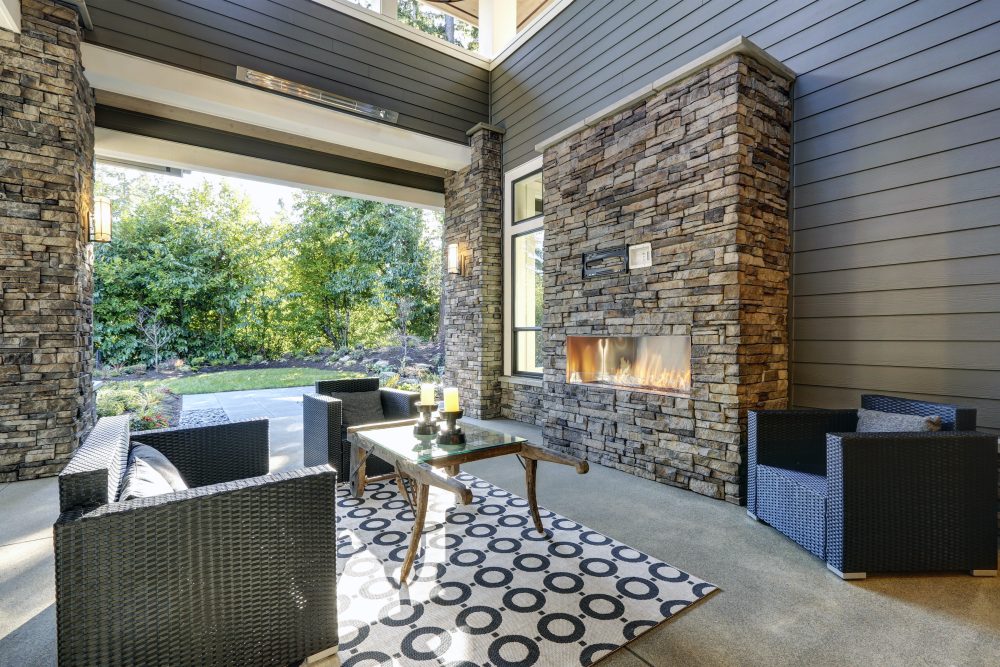When it comes to creating a cozy and inviting outdoor space, an outdoor fireplace can be a wonderful addition. Not only does it provide warmth and ambiance, but it also adds a touch of elegance to your backyard gatherings. However, before you invest in one, it’s essential to understand the pros and cons of different types of outdoor fireplaces. In this blog, we’ll explore the pros and cons of gas vs. wood-burning outdoor fireplaces.

Gas Burning Outdoor Fireplaces
Pros
Convenience: Gas-burning fireplaces are incredibly easy to use. With just a flip of a switch or the push of a button, you can instantly ignite a beautiful flame. There’s no need to gather wood, stack it, and tend to the fire.
Cleanliness: Gas fireplaces produce minimal ash and soot compared to wood-burning alternatives. This means less mess to clean up after your outdoor gathering.
Control: Gas fireplaces allow for precise control over the flame height and intensity. You can adjust the heat output to your liking, ensuring a comfortable ambiance for everyone.
Quick Start and Stop: Want a fire for a short while? Gas fireplaces are perfect for this, as they can be easily turned on and off without much hassle.
Cons
Less Authenticity: Gas fireplaces lack the crackling sounds and woodsy aroma that are associated with traditional wood-burning fires. Some people prefer the authentic experience of a real wood fire.
Initial Cost: Gas fireplaces tend to have higher upfront costs due to installation and gas line requirements. However, the long-term savings in terms of convenience and maintenance might balance this out.
Dependence on Gas: Gas fireplaces rely on a steady supply of gas, which might be an issue during power outages or in areas with limited gas availability.
Wood Burning Outdoor Fireplaces
Pros
Classic Atmosphere: Nothing quite beats the genuine ambiance of a wood-burning fire. The crackling sound and the earthy scent of burning wood create a cozy and nostalgic atmosphere.
Versatility: Wood-burning fireplaces can accommodate various types of wood, each imparting unique scents and colors to the fire. This allows you to tailor the experience to your preferences.
Cost-effective: While there’s an initial investment in firewood, wood-burning fireplaces are generally more cost-effective to operate since you’re not reliant on gas fuel.
Cons
Maintenance: Wood-burning fireplaces require more effort in terms of gathering, storing, and preparing firewood. You’ll also need to clean out ash and debris regularly.
Safety Concerns: Wood fires can produce sparks and embers that pose a fire hazard, especially in windy conditions. Extra caution is needed to ensure the fire is contained.
Air Quality: Burning wood releases pollutants into the air, potentially contributing to air quality issues in densely populated areas. Some regions have restrictions on wood burning due to environmental concerns.
After seeing our list of the pros and cons of gas vs. wood-burning outdoor fireplaces, the choice between the two comes down to your personal preferences and lifestyle. If you prioritize convenience, cleanliness, and precise control, a gas fireplace might be your ideal choice. On the other hand, if you’re drawn to the authentic crackling sounds, natural aroma, and classic charm of a wood-burning fire, then that’s the way to go. Whichever option you choose, an outdoor fireplace is sure to create cherished memories during your outdoor gatherings. So, contact us at Varsity Pools to have your beautiful outdoor fireplace installed today!
